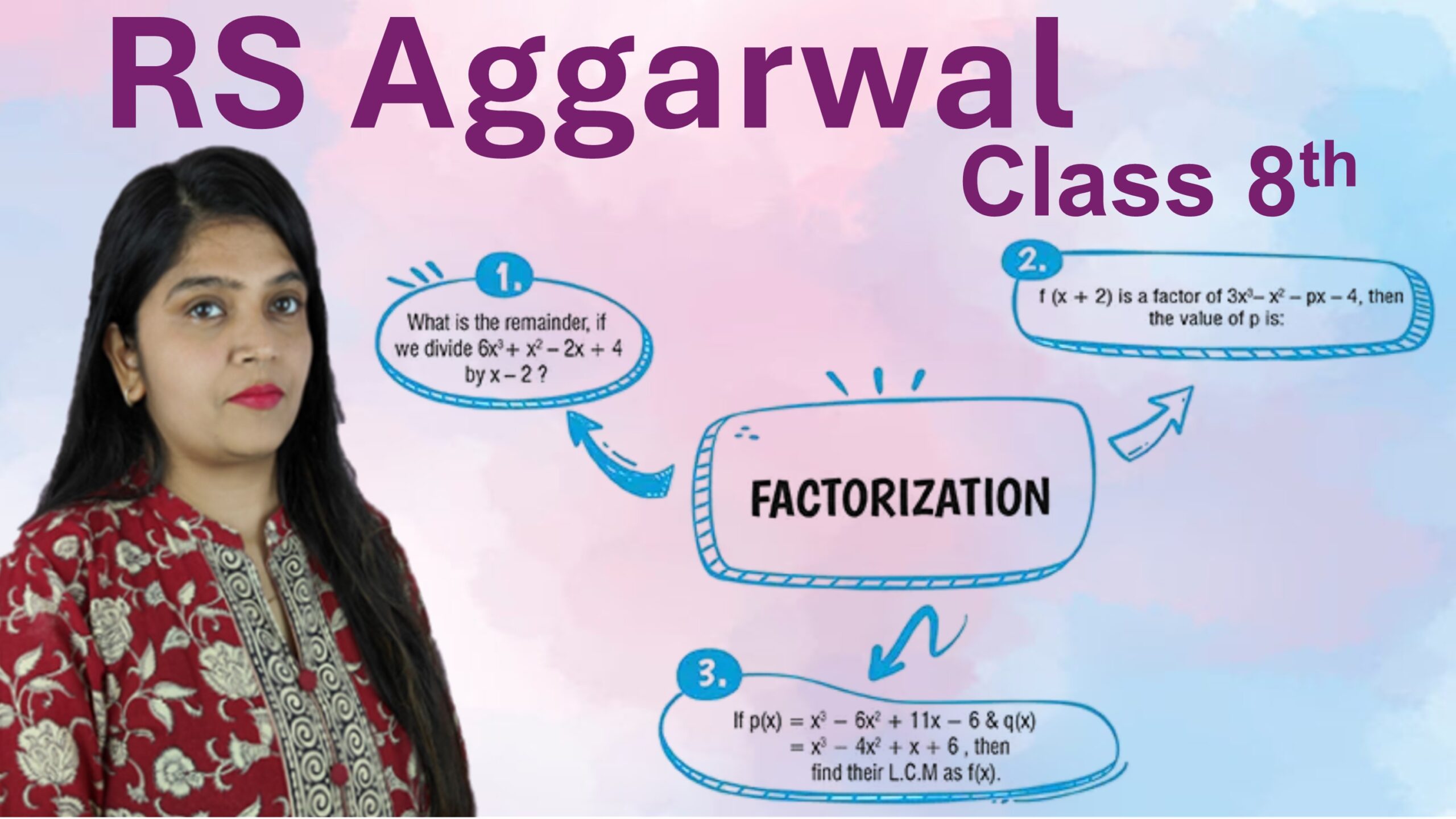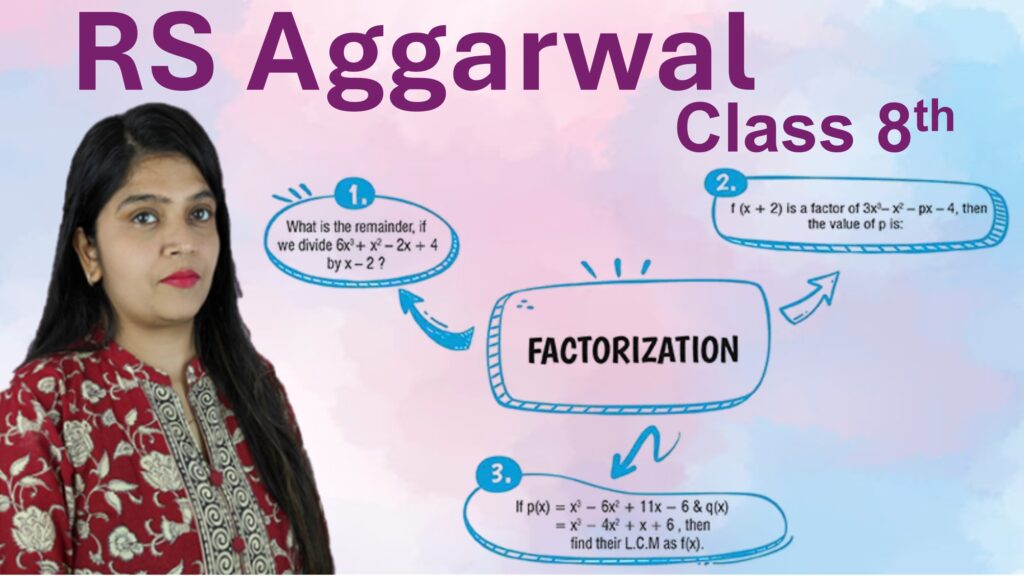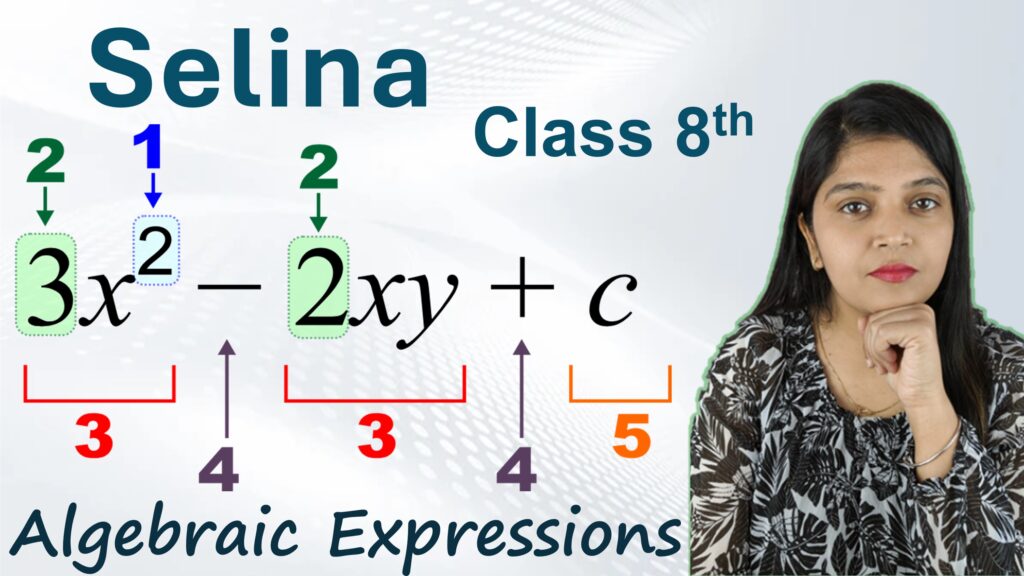Competency Focused Questions
Q1: \(a^2b+a^2c+ab+ac+b^2c+c^2b\) is same as:
Step 1: Group the terms sensibly
\((a^2b + a^2c + ab + ac) + (b^2c + c^2b)\)
Step 2: Factor each group
From the first group: \(a^2b + a^2c + ab + ac = a(a(b+c)) + 1(a(b+c)) = (a^2 + 1)(b+c)\)
From the second group: \(b^2c + c^2b = bc(b+c)\)
Step 3: Combine the common factor \((b+c)\)
\((a^2 + 1)(b+c) + bc(b+c) = (a^2 + 1 + bc)(b+c)\)
Answer: a. \(\left(a^2 + 1 + bc\right)\left(b+c\right) \)
Q2: \(x^2+\frac{1}{x^2}-\frac{3}{x}+2-3x\) can be factorised as:
Step 1: Combine terms and try to write in the form of \((x+\frac{1}{x})\) if possible
\[
x^2 + \frac{1}{x^2} – 3x – \frac{3}{x} + 2 \\
= \left(x^2 + \frac{1}{x^2}\right) – 3\left(x + \frac{1}{x}\right) + 2
\]Step 2: Let \(y = x + \frac{1}{x}\)
Then \(x^2 + \frac{1}{x^2} = y^2 – 2\)
Substitute:
\[
y^2 – 2 – 3y + 2 = y^2 – 3y
\]Step 3: Factor \(y^2 – 3y\)
\[
y(y – 3)
\]Step 4: Substitute back \(y = x + \frac{1}{x}\)
\[
\left(x + \frac{1}{x}\right) \left(x + \frac{1}{x} – 3\right)
\]Answer: d. \(\left(x + \frac{1}{x}\right)\left(x + \frac{1}{x} – 3\right)\)
Q3: Which among the following expressions is not in factorised form?
Given Options:
a. \((2ab+5)(a+2)\)
b. \(5a + 2ab + 14\)
c. \(5(a+3)\)
d. \(2a^2 + 9(a-2)\)
Step 1: Recall that an expression is in factorised form if it is written as a product of two or more expressions.
Step 2: Check each option:
– a. \((2ab+5)(a+2)\) → Product of two expressions → factorised form ✅
– b. \(5a + 2ab + 14\) → Sum of terms, not written as a product → not factorised ❌
– c. \(5(a+3)\) → Product of 5 and (a+3) → factorised form ✅
– d. \(2a^2 + 9(a-2)\) → Sum of terms, can be factorised further → not fully factorised, but as given, it is not written as a single product ❌
Step 3: Among the options, the one clearly not in factorised form is option b.
Answer: b. \(5a + 2ab + 14\) and d. \(2a^2+9\left(a-2\right)\)
Q4: While factorising the algebraic expression \(20x^2+5xy^2-25xyz\), a student followed the steps given below:
In which step did he make his first mistake?
Given Steps:
Step I: \(5 \times 2 \times 2 \times x \times x + 5 \times x \times y \times y – 5 \times 5 \times x \times y \times z\)
Step II: \(5 \times x \left( 2 \times 2 + y \times y + 5 \times y \times z \right)\)
Step III: \(5x \left( 4 + y^2 + 5yz \right)\)
Step 1: Check Step I: Break each term into factors.
– \(20x^2 = 5 \times 4 \times x^2 = 5 \times 2 \times 2 \times x \times x\) ✅
– \(5xy^2 = 5 \times x \times y \times y\) ✅
– \(-25xyz = -5 \times 5 \times x \times y \times z\) ✅
Step I is correct.
Step 2: Factor out \(5x\):
– \(5x( 4x + y^2 – 5yz )\) → Correct factoring should be:
\(\ 5x ( 4x + y^2 – 5yz ) \) ✅
– But in Step II, student wrote: \(5x( 2 \times 2 + y \times y + 5 \times y \times z ) = 5x( 4 + y^2 + 5yz )\)
– Mistake: Sign of \(-25xyz\) becomes \(+5yz\) instead of \(-5yz\).
Step 3: Step III uses the wrong sign: \(5x(4 + y^2 + 5yz)\) ❌
– The correct factorisation is \(5x(4x + y^2 – 5yz)\)
Answer: b. Step II
Q5: We can regroup the terms of \(3x+4y+4xy+3\), so that it can be factorised, as:
Step 1: Look for terms that can be grouped to take common factors.
The given expression is:
\(3x + 4y + 4xy + 3\)
Step 2: Group terms in different ways:
Option (a) grouping: \((4xy + 3x) + (4y + 3)\)
Option (b) grouping: \((4xy + 4y) + (3x + 3)\)
Step 3: Factor each group:
– Option (a): \((4xy + 3x) + (4y + 3) = x(4y + 3) + 1(4y + 3) = (x+1)(4y + 3)\) ✅
– Option (b): \((4xy + 4y) + (3x + 3) = 4y(x + 1) + 3(x + 1) = (4y + 3)(x + 1)\) ✅
Step 4: Both groupings lead to the same factorised result:
\((x + 1)(4y + 3)\)
Answer: c. both (a) and (b) are correct
Q6: The expression \(3x^2-11x+6\) is factorised into two terms. The sum of these two factors is:
Step 1: Multiply the coefficient of \(x^2\) and the constant term:
\(3 \times 6 = 18\)
Step 2: Find two numbers whose product is 18 and sum is -11:
Numbers are -2 and -9, because \((-2) \times (-9) = 18\) and \(-2 + -9 = -11\)
Step 3: Split the middle term using these numbers:
\(3x^2 – 2x – 9x + 6\)
Step 4: Group terms:
\((3x^2 – 2x) – (9x – 6)\)
Step 5: Factor each group:
\(x(3x – 2) – 3(3x – 2)\)
Step 6: Take out the common factor:
\((x – 3)(3x – 2)\)
Step 7: Sum of the two factors:
\((x – 3) + (3x – 2) = 4x – 5\)
Answer: c. 4x – 5
Q7: Which of the following is true for the expression \(a^2-8a-16b^2+16\)?
Step 1: Group terms to prepare for factorisation:
\((a^2 – 8a) – (16b^2 – 16)\)
Step 2: Factor each group:
\(a(a – 8) – 16(b^2 – 1)\)
Step 3: Notice \(b^2-1\) is a difference of squares:
\(a(a – 8) – 16(b – 1)(b + 1)\)
Step 4: Check if further factorisation by grouping is possible:
Expression can be rewritten as:
\((a – 4)^2 – 16b^2 = (a – 4 – 4b)(a – 4 + 4b)\)
Step 5: Combine with remaining term (if any) to express completely:
Here, the complete factorisation yields two factors:
\((a – 4 – 4b)(a – 4 + 4b)\)
Answer: b. Its one factor is (a – 4 – 4b)
Q8: 8. Area of floor of a hall is given by the expression \(\left(a^2+9a+20\right)\ \) m². If \(a=2\) m, which of the following can be the dimensions of the hall?
Step 1: Factorise the quadratic expression \(a^2 + 9a + 20\):
We need two numbers whose product = \(20\) and sum = \(9\).
These numbers are \(4\) and \(5\).
Thus, \(a^2 + 9a + 20 = (a + 4)(a + 5)\).
Step 2: As area = Length × Breath, so Length = (a + 5) and Breadth = (a + 4).
Now Substitute \(a = 2\):
So Length = (2 + 5) = 7m and Breadth = (2 + 4) = 6m.
Answer: b. length = 7 m, breadth = 6 m







Leave a Comment